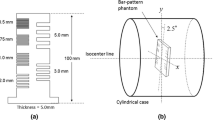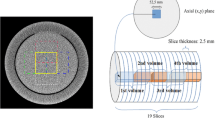Abstract
Purpose
The edge response behavior of multi-detector row computed tomography (MDCT) in high-spatial- frequency sampling may diminish due to fluctuations, so a method for improving the edge response was developed and tested.
Method
MDCT enables thin-slice and high-speed scanning compared with conventional single-detector row CT (SDCT). However, MDCT uses increased volume scanning with a simultaneous increase in the radiation dose to patients. Recently, we proposed a fluctuation reduction method using high-spatial-frequency data sampling; however, the edge response in the processed image decreased. In this research, we investigate the edge response behavior in the high-spatial-frequency sampling, and propose a method for improving the edge response. To verify this method, a large water phantom that consists of five resinous rods and a small phantom with a similitude rate of 0.5, which is topologically similar to the former large phantom were scanned, and projection data sampling using high-spatial-frequency was simulated. Thereafter, reconstructed images were obtained by averaging the high-spatial-frequency sampling data, edge gradients of profiles were calculated, and the increased rate of the gradient values were evaluated.
Results
This method increased the image noise slightly and provided higher gradient values with the same image matrix size as the conventional scans could be obtained without special image processing. In this phantom study, in order to simulate the high-spatial-frequency sampling, a large phantom was scanned and the fluctuation of transmitted X-rays was increased, thereby increasing the noise.
Conclusion
A phantom study of projection data sampling by high-spatial-frequency sampling was simulated in the x- and y-direction by scanning two phantoms, and the improvement in the edge response by this method produced 25–97% improvement using double-spatial-frequency sampling. If low-noise or high-sensitivity detector is developed, this method may be more effective.
Similar content being viewed by others
References
Endo M, Tsunoo T, Kandatsu S, Tanada S, Aradate H, Saito Y (2003) Four-dimensional Computed Tomography (4D-CT)—concepts and preliminary development. Radiat Med 21(1): 17–22
Donoho DL (1993) Nonlinear wavelet methods for recovery of signals, densities, and spectra from indirect and noisy data. Proc Symp Appl Math 47:173–205
Donoho DL (1995) De-noising by soft-thresholding. IEEE Trans Inform Theory 41(3):613–627
Reiter E (1996) Wavelet compression of medical imagery. Telemed J 2(2):131–137
Tikkanen PE (1999) Nonlinear wavelet and wavelet packet denoising of electrocardiogram signal. Biol Cybernet 80(4):259–267
Cherkassky V, Kilts S (2001) Myopotential denoising of ECG signals using wavelet thresholding methods. Neural Netw 14(8):1129–1137
Harpen MD (1999) A computer simulation of wavelet noise reduction in computed tomography. Med Phys 26(8): 1600–1606
Yasuda N, Ishikawa Y, Kodera Y (2005) Improvement of Image Quality in Chest MDCT Using Nonlinear Wavelet Shrinkage with Trimmed-thresholding. Jpn J Radiol Technol 61(12):1599–1608
Yasuda N, Abe S, Nishimura K, Sato H, Tomida T, Muraishi H, Kanai T, Tazawa S, Kawachi K (2003) Comparison of Wavelet Shrinkage and Fourier Noise Reductions in Heavy Ion Computed Tomography. In: Proceedings of the World Congress on Medical Physics and Biomedical Engineering, [CD-ROM] ISBN 1877040142
Sasaki T, Hanari T, Sasaki M, Oikawa H, Gakumazawa H, Okumura M, Ikeda Y, Toyoshima N (2004) Reduction of radiation exposure in CT perfusion study using a quantum de-noising filter. Jpn J Radiol Technol 60(12):1688–1693
Daubechies I (1988) Orthogonal bases of compactly supported wavelets. Comm Pure Appl Math 41:909–996
Mallat SG (1989) A theory for multiresolution signal decomposition: the wavelet representation. IEEE Trans Pattern Anal Mach Intell 11(7):674–693
Daubechies I (1990) The wavelet transform, time-frequency localization and signal analysis. IEEE Trans Inform Theory 36(5):961–1005
Mallat S, Zhong S (1992) Characterization of signals from multiscale edges. IEEE Trans Pattern Anal Mach Intell 14(7):710–732
Uchiyama Y, Yamamoto K (1998) Enhancement of fine structure in medical image using wavelet analysis. J Comput Aid Diagn Med Images 2(1):1–6
Petrascu O, Bel A, Linthout N, Verellen D, Soete G, Storme G (2000) Automatic on-line electronic portal image analysis with a wavelet-based edge detector. Med Phys 27(2):321–329
Laine A, Fan J, Schuler S (1994) A framework for contrast enhancement by dyadic wavelet analysis. In: Proceedings of the 2nd international workshop on digital mammography, pp 91–100
Yasuda N, Ishikawa Y, Kodera Y (2006) Improvement of image quality in MDCT by high-frequency sampling of x-, y- and z-direction. In: Proceedings of the international society for optical engineering, vol 6144, pp 61446C-61441–61448
Glover GH, Pelc N J (1980) Nonlinear partial volume artifacts in X-ray computed tomography. Med Phys 7:238–248
Zou Y, Sidky EY, Pan X (2004) Partial volume and aliasing artefacts in helical cone-beam CT. Phys Med Biol 49:2365–2375
Iwamoto S, Shiozaki A (2006) Statistical influence of logarithmic transform of projection data with noise and a simple correction method. (in Japanese) Med Imag Tech 24(3): 209–215
Author information
Authors and Affiliations
Corresponding author
Rights and permissions
About this article
Cite this article
Yasuda, N., Ishikawa, Y. & Kodera, Y. Improvement of edge response in multi-detector row CT by high-spatial-frequency sampling of projection data. Int J CARS 1, 311–320 (2007). https://doi.org/10.1007/s11548-007-0067-7
Received:
Accepted:
Published:
Issue Date:
DOI: https://doi.org/10.1007/s11548-007-0067-7




